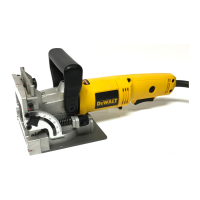ENGLISH
34
When joining narrow workpieces such as picture
frames, even the smallest biscuits may be too large
for the joint. In this case, the exposed tip of the
biscuit should be trimmed off after the joint has been
glued (fig. 13b).
When joining workpieces thicker than approx.
2.5 cm, pairs of biscuits may be used for additional
strength (fig. 13c).
To mark mating pieces, first position them as they
will be assembled. Use a set square to draw the
marking line across the pieces (fig. 13d).
Cutting Biscuit Slots (fi g. 14)
1. Adjust the tool settings as described above.
2. Align the centre marking on the tool base with
the marking line as shown.
3. Switch the tool on and wait a second for the
cutter attain full speed.
4. Firmly push the fence against the workpiece
and plunge the cutter until the stop is reached.
5. Allow the tool to retract the blade from the
workpiece.
6. Turn the tool off.
Assembling the Workpieces
1. Try assembling the workpieces together to
check that the joints fit correctly.
2. Evenly spread a suitable glue in the biscuit slots
and on the mating surfaces of the joint.
3. Insert the biscuits into the slots, ensuring that
they come into contact with the glue.
4. Assemble the workpieces and clamp them until
the glue has dried.
Edge to Edge Joints (fi g. 15a, 15b)
1. Place the workpieces on a flat surface as they
are to be assembled.
2. Mark the biscuit centres. The biscuits should be
located at 15–25 cm intervals; the outer biscuits
should be located 5–7.5 cm from
the ends of the workpiece (fig.15a).
3. Set the fence to 90°.
4. Set the height adjuster to position the biscuit in
the centre of the workpiece.
5. Adjust the other tool settings as described
above.
6. Cut the biscuit slots as described above
(fig. 15b).
Frame Joints (fi g. 16a–16c)
1. Place the workpieces on a flat surface as they
are to be assembled (fig. 16a, 16b).
2. Select the appropriate biscuit size.
3. Mark the biscuit centres.
4. Adjust the tool settings as described above.
5. Cut the biscuit slots as described above
(fig. 16c).
Corner Joints (fi g. 17a, 17b)
1. Arrange the workpieces as they are to be
assembled (fig. 17a).
2. Select the appropriate biscuit size.
3. Mark the biscuit centres.
4. For the face cut, clamp the workpiece and align
the tool as shown (fig. 17b)
5. Cut the biscuit slots as described above.
Offset Joints (fi g. 18)
When joining two workpieces of different thickness,
proceed as follows:
1. Arrange the workpieces as they are to be
assembled.
2. Select the appropriate biscuit size.
3. Mark the biscuit centres.
4. Select the workpiece that will be set back.
5. Set the height adjuster to position the biscuit in
the centre of the workpiece.
6. Cut the biscuit slots as described above.
7. Adjust the fence up by a distance equal to the
desired offset. Use the scale to read the setting.
8. Cut the biscuit slots as described above.
Edge Mitre Joints (fi g. 19a–19d)
OUTSIDE SURFACES ALIGNED
1. Arrange the workpieces as they are to be
assembled.
2. Mark the biscuit centres on the outside of
the joint.
3. Set the fence angle to 90°.
4. Adjust the fence to locate the biscuit toward the
inside of the joint where the workpiece is thicker.
Select the appropriate biscuit size (fig. 19b).
5. Clamp the workpiece and align the tool as
shown (fig. 19c).
6. Cut the biscuit slots as described above.

